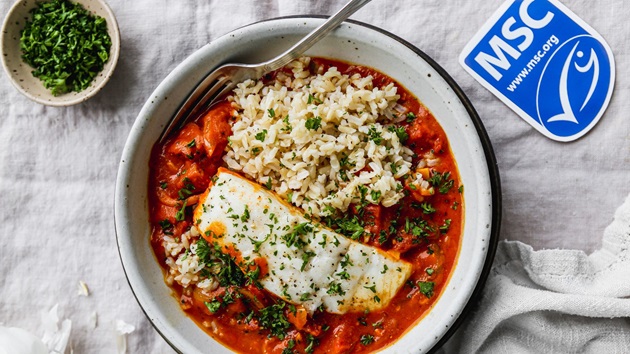We’re all affected by inflation. As such, food preservation, waste reduction and a focus on multi-functional foods are all having a big moment. But it’s not just about utility; as you’ll see, the seafood trends you can expect in the year ahead are also about creativity!
Colouring (and Curing) Outside of the Lines

Taking a cue from hyper-coloured squid or beet-inked pastas and sauces – the Crudo and Bagel Board trends get recoloured. Colour-curing your fish is easy, reduces and makes use of kitchen waste, and is ready for Instagram! Curing your fish and seafood is easy to do at home and this application is visually appealing. Having intensely coloured food also signals health and nutritious ingredients. Curing your fish for bagel boards using kitchen scraps like beet peels, or “past their prime” berries adds bright magenta and purple hues to your plates…as well as complexity in flavour.
Preserving Seafood Beyond the Tin

There’s a saying in Iceland: “lífið er saltfiskur” or “life is salted fish.” Preservation and flavour-boosting in one, thanks to inflation, this age-old technique becomes once again an economic staple at home. Salting and preserving any kind of fish is a way to prolong the ‘shelf life’ of your MSC certified seafood and touches on (trendy) ‘heritage’ and ‘nostalgic’ cooking techniques and dining experiences. Saltfish with Ackee (a Caribbean staple),-bacalhau,-(the star of numerous European classics), and Asian cuisine’s focus on dried/salted fish and seafood are just a few examples. The act of salting and preserving fish is a tradition across cultures and geographies throughout time.
Stuffing Your Sandwiches With Seafood
.png?Status=Master&sfvrsn=9010a7b5_1)
From nori crunch wraps to stuffing seafood shells to calamari tubes…seafood “sandwiches” get a holistic revamp. TikTok and Instagram are flooded with videos of Onigari (rice balls sometimes in triangular formations) or Onigarazu (sushi sandwiches) using everything from MSC canned tuna to scraping the last bits of fish from the bones. Accessible and affordable – they’re somewhere between a convenient lunch and a satisfying snack.
Ocean-Flavoured Snacks for People and...Pets?

“The global snacking industry is currently estimated to be worth around $1.2T, thanks to a strong appetite for convenience and a growing preference for eating smaller bites throughout the day rather than a few large meals.” (WGSN Food & Drink Trends: The Snack Economy by Matt Poile 01/18/2022). Seafood snack kits from MSC partners like Ocean’s, Cloverleaf, Freshe and more to come in early 2023, have all hit the market of late and offer healthier, protein-rich and satisfying snack options.
Seafood and fish snacks can also be prepared at home too. From fish and seafood-flavoured chips to using (air-frying) shrimp shells and grinding them up into a flavoured powder topping and garnish – this is a versatile way to “add the flavour of the ocean” to salads and a great way to make use of flavourful seafood scraps.
The seafood snack craze is also applicable and trendy in the ever growing category of pet treats for our fur babies.
Prioritizing Gut and Brain Health with Fermented Foods

In an increasingly wellness-focused world, both gut and brain health are checked off with nutrient-rich fermented foods. This ‘functional food’ is a big part of what modern wellness is about. Fermented dishes like Jeotgal (small portions of fermented seafood such as fish, shellfish, and other marine animals in Korean cuisine) are showing up on menus to replace fried calamari as a healthier, gut health enhancing option for shareable starters. It is usually eaten as banchan (Korean side dish). Many types of fish and seafood are known for being protein-rich, high in Omega 3s, and having these qualities: packed with saline and savoury flavour, can slightly boost cognitive function, provide gut health support and some protection for your immune system. Double down on these healthy elements with various sea vegetables or soy and miso marinades for the health benefits that fermentation serves up.
Verifying Those Sustainability Claims Seen in Stores

During the pandemic, the demand for pre-packaged fish and seafood increased as many fish counters closed and retailers relied more heavily on suppliers to portion out and label their offerings on pack. Though the market for fresh fish and seafood has opened back up, the rising cost of food now greatly impacts food choices and has many consumers continuing to turn to portioned and packaged fish. Consumers still require clear labelling on their fish and seafood in order to determine the overall quality and ensure it’s sustainably sourced – the MSC blue fish label is the gold standard here. All fish and seafood with the blue MSC label is certified sustainable and can be traced back to a sustainable source. More than ever, according to the latest MSC consumer research, 68% of North Americans believe that people should consume fish and seafood only from sustainable sources (up 10 points from 2020).
Shining a Spotlight on Sardines

Often overlooked and underappreciated; sardines are becoming popular due to their growing reputation for having anti-aging qualities. Health conscious consumers know they are a good source of calcium, protein, and omega-3 fatty acids and are said to have less mercury than other fish. They are increasingly used in pasta sauces, continue to punch up salad dressings and now even become the main event on the plate. And if you can find them fresh, bonus! In this wave of inflation, these affordable, versatile, and nutritious fish become the new school of restaurant menuing at home.
Transport Through Time With Your Tastebuds

Nostalgic cooking takes us back to our childhoods, our favourite moments, around the world, and sometimes back to our roots. Millennial and Gen Z eating habits point towards re-working traditional family recipes and nostalgic favourites with the addition of superfoods and healthier takes. Things like Friday Fish Fry & Friday Fish Nights are a way to enjoy food together and create tradition and a sense of comfort. Simple recipes pulled from the family archives and enhanced with sometimes more luxurious ingredients are popular for at-home entertaining (example: Mac n’ Cheese now with cauliflower sauce and lobster meat (make sure it’s MSC certified sustainable!) as an elevated version of the beloved childhood classic).



